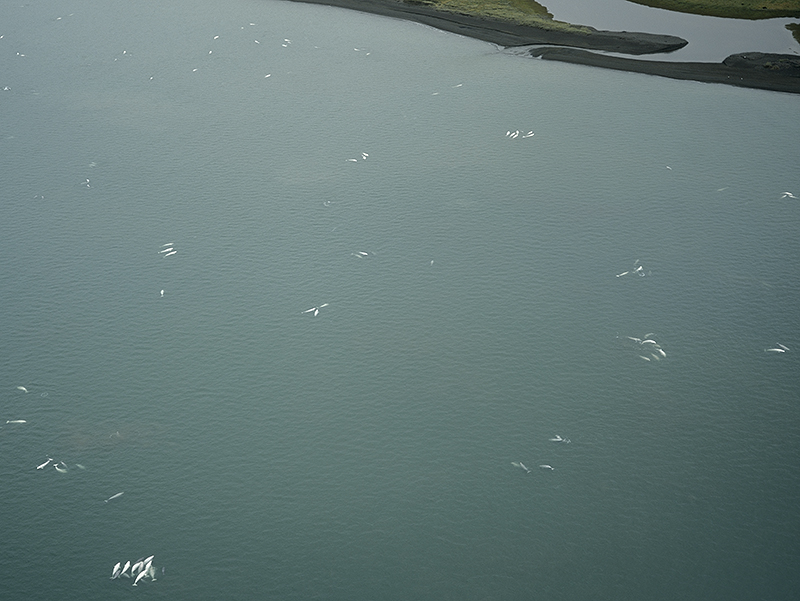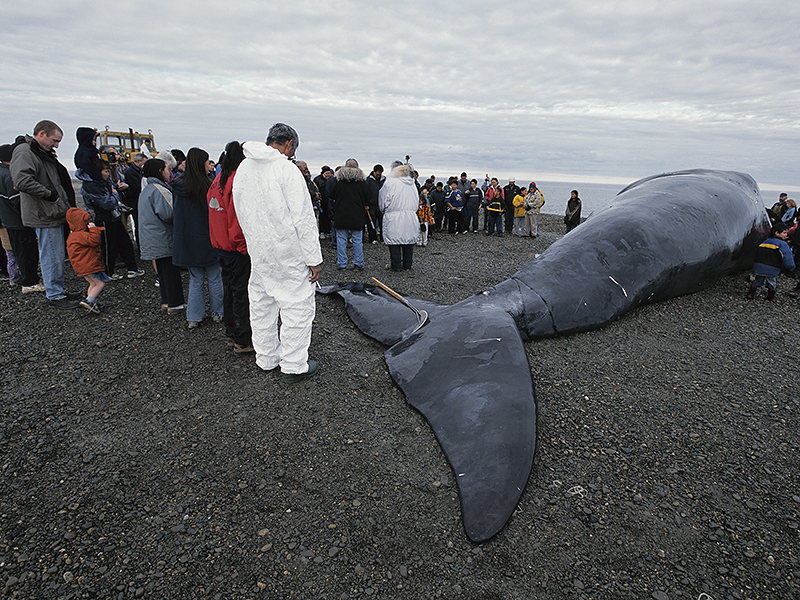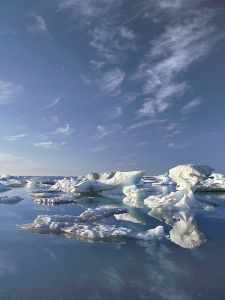This post first appeared on TomDispatch.
Here’s a Jeopardy!-style question for you: “Eight different species of whales can be seen in these two American seas.” Unless you’re an Iñupiaq, a marine biologist or an Arctic enthusiast like me, it’s a pretty good guess that you can’t tell me what those seas are or what those whales are either. The answer: the Chukchi Sea and the adjacent Beaufort Sea, off Arctic Alaska, and you can commonly spot bowhead, beluga and grey whales there, while fin whales, minkes, humpbacks, killer whales and narwhals are all venturing into these seas ever more often as the Arctic and its waters continue to warm rapidly.
The problem, however, is that the major oil company Royal Dutch Shell wants to drill in the Chukchi Sea this summer and that could, in the long term, spell doom for one of the last great, relatively untouched oceanic environments on the planet. Let me explain why Shell’s drilling ambitions are so dangerous. Just think of the way the blowout of one drilling platform, BP’s Deepwater Horizon, devastated the Gulf of Mexico. Now, imagine the same thing happening without any clean-up help in sight.
You might have heard about The Sixth Extinction, the way at this moment species are blinking off at a historically unprecedented rate. The Arctic seas of Alaska, however, still are sanctuaries not only for tens of thousands of whales, but also hundreds of thousands of walruses and seals, millions of birds, thousands of polar bears and innumerable fish from more than one hundred species, not to mention all the uncharismatic sub-sea life that eludes our eyes but makes up the food web — phytoplankton, sea urchins, sand dollars and sea cucumbers, to name only a few. Think of the Arctic Ocean as among the last remaining marine ecological paradises on the planet.

Beluga Whales with calves near Kasegaluk Lagoon along the Chukchi Sea coast, July 2006. About 4,000 beluga whales are known to calve along that lagoon. On this day in early July, we saw nearly 1,000 whales with newborn calves within a one-mile stretch. (Photo: Subhankar Banerjee).
Now for that oil. Looking for it in Arctic waters happens to be the most dangerous form of drilling imaginable, because no proven technology exists that could clean up a major oil spill in distant ice-choked seas in the cold and dark, under one of the harshest environments on Earth. Even during the brief “summer” open-water season, ice floes remain a constant threat as Shell found out in 2012 when one of its drill ships encountered a floe the size of Manhattan and was forced to disconnect from its seafloor anchor and temporarily halt its operations. Deep fog severely restricts visibility. Storms are not exceptions but the norm, and are becoming more frequent and violent in a rapidly warming region.
I’ve spent much time in the Arctic and, believe me, it’s a forbidding environment for outsiders. In late September, as summer gives way to autumn, ice begins to form in the seas and darkness descends. Any spill that occurs late in the brief potential drilling season would remain untouched and unattended to until the ice melted the following summer. But even if such a blowout occurred in summer, there is no infrastructure in place to respond to a disaster. The nearest Coast Guard station is more than 1,000 miles away. And keep in mind that a disaster of this sort would not remain conveniently contained in the Arctic. As a recent US National Research Council study on responding to an Arctic offshore oil spill puts it, “The risk of an oil spill in the Arctic presents hazards for the Arctic nations and their neighbors.”
Add to this potential nightmare scenario another little fact: Shell has garnered a well-deserved reputation as “the company with the spottiest Arctic record.” In September 2012, it initiated exploration drilling in US Arctic waters with a conditional permit from the Obama administration, only to end a disastrous year in which one of its two drill rigs, the Kulluk, was grounded in the Gulf of Alaska on New Year’s Eve. The other ship, Noble Discoverer, suffered damage after catching fire, while both were fined by the Environmental Protection Agency for violating the Clean Air Act and the contractor Noble Drilling pleaded guilty in 2014 to all eight felony charges leveled against it for environmental violations and agreed to ante up $12.2 million in fines and community service payments. Because of the damage to its rigs, Shell was forced to give up its 2013 drilling plans. A court ruling in January 2014 in favor of local Iñupiat tribes and environmentalists forced the company not to drill that summer either.
Since then, the price of oil has plunged, sending a shock wave across the oil industry and deep-sixing all sorts of prospective plans planet-wide to drill in Arctic waters: Norway’s Statoil shelved its 2015 drilling plan in the Barents Sea off that country’s northern coast and handed back the three leases it had purchased in the Baffin Bay off the west coast of Greenland. Chevron put its plan to drill in Canada’s Beaufort Sea on indefinite hold. Following the Ukraine crisis and American sanctions on Russia, ExxonMobil was prohibited from working with the oil company Rosneft on a joint plan to drill in the Kara Sea in the Russian Arctic. Even had those sanctions not been in place, the low price of oil would have made such exploration a far less appetizing prospect for the moment.
“It is up to Shell then to keep the oil industry’s Arctic dreams alive,” one journalist suggested and indeed, on January 29th, that company announced that, after a two-year hiatus, it would drill this summer in the Chukchi Sea. Two weeks later, the Obama administration issued its final supplemental environmental impact statement on the site where the drilling would take place, the controversial Chukchi Lease Sale 193, bringing Shell’s plan one step closer to reality.
But before considering the politics of oil drilling there, let’s take a little dive into the Arctic Ocean and the history of its exploitation.
Who Owns the Arctic Ocean?
For more than four centuries, western nations have regarded the Arctic Ocean as an economic treasure chest. The oil harvested from Arctic whales helped fuel the economies of countries in Europe and North America and drove the magnificent bowhead whale to near extinction.

Prayer after a whale hunt. Iñupiat Elder Isaac Akootchook and whaling captain James Lampe offer a prayer to thank the Creator and the whale for offering food for the community, Kaktovik, along the Beaufort Sea coast, September 2001. (Photo: Subhankar Banerjee).
In February 1880, the future creator of Sherlock Holmes, Arthur Conan Doyle, then a 20-year-old medical student, interrupted his studies for a six-month voyage on the Arctic whaler, Hope, as the ship’s surgeon. From his diary we learn that the drive to profit trumped any concern about the possible extinction of the bowhead, or Greenland, whale. “Price tends to rise steadily for the number of the creatures is diminishing,” he wrote, “probably not more than 300 of them left alive in the whole expanse of the Greenland seas.” On another day, he added that, “[T]he creatures… own those unsailed seas.” Of course, those seas were anything but “unsailed” as commercial ships were plying them to harvest whales, so consider that instead Doyle’s euphoric expression of how it felt to him to see the life in that ocean.
Today, to the extent that seas can be “owned,” governments own them and are selling pieces off to the highest bidders — oil companies. Ownership or territorial control for commercial exploitation is, however, only one side of the story of the Arctic Ocean. The magnificent and complex ecology of the northern seas is now being altered by three human-caused phenomena: climate change, ocean acidification and pollution.
Arctic sea ice is vanishing at an astonishing rate thanks to climate change, which is having devastating impacts on the region’s polar bears and walruses. In the southern Beaufort Sea of Alaska and Arctic Canada, the polar bear population declined by 40 percent between 2001 and 2010. Meanwhile, in six of the last eight years, tens of thousands of Pacific walruses have hauled themselves out onto barrier islands and tundra along the Chukchi Sea because there was no sea ice left for them to rest on. Onshore, walruses are far from their food sources and young walruses are particularly susceptible to being trampled to death by the adults in the colony.
Commercial whaling in the region, which started in 1848, ended by about 1921, when petroleum supplanted whale oil as the fuel of choice. With no industrial activity in those waters for more than half a century, the bowhead population slowly began to recover. Whales don’t depend on sea ice the way polar bears and walruses do, so in 2011 the bowhead population in the US Arctic was estimated at almost 17,000 and is increasing by 3.7 percent per year.
The half-century of commercial calm in the Beaufort and Chukchi seas ended, however, in the late 1970s, when oil exploration began. By the early 1990s, the expensive hunt for oil in Arctic seas had largely failed and almost all leases were relinquished. The second wave of US Arctic offshore oil and gas exploration only started when George W. Bush took office. Between 2003 and 2008 leases were sold on more than three million acres in the Beaufort and Chukchi seas, while generating substantial controversy and court challenges from the tribal Iñupiat peoples and environmental groups. The persistence of this resistance to drilling, along with the recent price collapse, has marked the second boom-and-bust cycle in Arctic exploration. The French company Total, for instance, simply walked away from the US Arctic in 2012 pointing out that offshore drilling there could lead to a “disaster,” and other companies have put exploration on indefinite hold — but not Shell.
Inevitability and Rush
Historically, government-sponsored research on the US Arctic has been driven not by that hallmark of science, curiosity, but by the desire to drill for oil and gas — by, that is, two impulses that are quite unscientific in nature. The first is an oil-company-inculcated urge to transform the decision to drill into a sense of inevitability and the second is an oil-company-sponsored urge to rush the process.
In fact, according to the National Research Council oil spill response study, systematic data collection in the Beaufort and Chukchi seas only began in the late 1970s — in other words, just as the first wave of Arctic offshore oil exploration was revving up. Onshore, the situation was the same: the initial comprehensive study of the flora and fauna of Alaska’s Arctic National Wildlife Refuge only took place in the mid-1980s, after the Reagan administration made a push to open it up to development — and (irony of ironies) the disastrous 1989 Exxon Valdez oil spill was what saved the refuge from industrial exploitation.
While there have only been sporadic studies of the marine environments in question since then, no comprehensive benchmark study for the Beaufort and Chukchi seas has ever been done; nor is there any thorough understanding of how the marine food web works in those seas, or of the population sizes and distribution of any but the sentinel species (whales, polar bears, walruses and seals). Even the data on them is considered “not reliable or precise enough to examine trends, evaluate influences from climate change, or estimate population-level damage in the event of an oil spill,” according to the National Research Council study.
The first benchmark study of the Hanna Shoal, one of the most biologically productive spots in the Chukchi Sea, only began in early August 2012. At the end of that month, the Obama administration gave Shell a conditional permit to begin drilling in the Beaufort and Chukchi seas. In other words, Arctic science hasn’t been guiding public policy, but rushing to catch up with the extractivist agenda of Big Oil.
Under the circumstances and given the perils of such extreme drilling in such an environment, what’s curious is the rush to inevitability exhibited by two successive administrations. And despite the recent collapse of oil prices, which makes such Arctic drilling prohibitively expensive and unprofitable, it hasn’t ended yet. On January 27th, the White House noted a conservation decision it had made with this reassuring headline at its website: “President Obama Protects Untouched Marine Wilderness in Alaska.” The president had indeed withdrawn 9.8 million acres of US Arctic waters, including Hanna Shoal, from future oil and gas lease sales. Just over two weeks later, however, the administration also issued the final supplemental environmental impact statement for Chukchi Lease Sale 193, which includes blocks of Arctic waters adjacent to and upstream from Hanna Shoal. In such waters generally, “protection” is an exaggeration in any case because, as one senior scientist from the Hanna Shoal study team put it in 2012, “anything that goes in the water at the drill sites may end up in this very productive region.”
Keeping Arctic Resources Underground
The leases the Bush administration sold in the Beaufort and Chukchi seas, Lease Sale 193 among them, generated substantial controversy and met with legal challenges. A coalition of native Alaskan and environmental organizations filed a lawsuit challenging the leases, the government’s inadequate gathering of baseline scientific data and its unwillingness to appropriately assess what a potential blowout would mean to the ecology of the regions and the life of indigenous cultures there.
As it turned out, the plaintiffs won twice, first in the US District Court for the District of Alaska in 2010, and then in the Ninth Circuit Court of Appeals in January 2014. Following that ruling, the Department of Interior finally went back to the drawing board and, on October 31, 2014, released a new draft supplemental environmental impact statement that acknowledged some of the ecological realities of drilling in Arctic seas. It suggested that there would be a 75 percent chance of one or more large oil spills (more than 1,000 barrels) if serious drilling began there and that any such spill could have catastrophic ecological consequences. The public comment period on the draft ended on December 22nd.
Nonetheless, this February, the Obama administration issued the final impact statement for Lease Sale 193 and sent the process forward. The Interior Department had by then taken less than two months, including the Christmas holiday season, to consider the more than 400,000 public comments it had received. “The analysis was rushed to cater to Shell’s desire to drill this summer,” Leah Donahey, Arctic Ocean senior campaign director with the Alaska Wilderness League, told me over the phone. Iñupiaq elder and conservationist Rosemary Ahtuangaruak emailed me this: “We are faced with a plan to drill in the Arctic Ocean — Our Ocean, Our Garden, Our Future. With a clean ocean we have our traditions and culture and our life, health and safety. We risk all of it with this decision.”
The question, of course, should be: in a country that has, in recent years, opened so many new drilling vistas from the Bakken Oil Fields of North Dakota to the Gulf of Mexico, creating what energy experts now call “Saudi America,” why is there still such a rush to industrialize the Arctic Ocean? Shell has a long history of trying to establish itself as a leader in Arctic exploration and drilling, and despite the inauspicious global situation for expensive forms of drilling, continues to push the process as fast as it can.
This, too, has long been the case. In the fall of 2010, for instance, the company launched a “We have the technology, let’s go” multi-million-dollar ad campaign to pressure the Obama administration to green-light the necessary permits for exploratory drilling in the Beaufort and Chukchi seas. In 2012, having gotten the necessary permits, it had a thoroughly disastrous drilling season, proving beyond a doubt that it did not “have the technology” to deal with the far North. Knowing that, and knowing as well that there is no proven technology for cleaning up a major oil spill in the ice-choked, forbidding, mostly dark environment of the Arctic seas, Shell is nonetheless back again.
As part of an ongoing competition among the major oil companies, Shell is clearly trying to establish itself as quickly as possible as the dominant player in Arctic offshore drilling, just as BP did in the Gulf of Mexico — with results that we remember well from the Deepwater Horizon blowout of 2010. Nonetheless, the Gulf looks like Club Med compared to the Arctic. To let Shell drill in the Chukchi Sea when the price of oil is low and its profits slumping would be a rash act indeed, given that a company under pressure elsewhere has a tendency to cut costs and compromise safety. Shell has already set a precedent. In 2012, the company’s decision to avoid Alaskan taxes resulted in moving its drill ship Kulluk from Alaska to Washington, only to see it grounded along the way.
Some things can be counted on like the sun setting in the West. In the extreme environment of the Arctic seas, a devastating oil spill is one of them if exploration is allowed to continue. The Obama administration, having just opened the southeastern Atlantic Coast to large-scale future oil exploration and drilling, is now poised to let Shell turn America’s Arctic waters into a disaster area. That it will happen sooner or later is a given should the company proceed. That Washington is still considering letting Shell do it anyway should amaze us all.
The final decision about whether to “end or affirm” the Chukchi Sea oil leases will be made on March 20th. Shell still needs approval on several permits before it can head north. The Obama administration cannot approve these permits until Lease Sale 193 is finalized. This may have contributed to the administration’s rushed analysis of that impact statement.
In January, the prestigious science journal Nature published a study adding one more obvious factor to an already grim equation. The development of oil and gas resources in the Arctic would, it wrote, be “incommensurate with efforts to limit average global warming to 2 degrees centigrade.” In other words, at a moment when the planet is experiencing an oil glut, it’s possible that the Obama administration will add yet another potential source of extreme oil to the list of future sources of the greenhouse warming of this planet.
Think of drilling in the Arctic as a future catastrophe in a single enticing package. In April, the United States takes over the chairmanship of the Arctic Council. If it decides to let Shell proceed, how will it present itself to the rest of the Arctic nation states, the indigenous Arctic nations and organizations, and the rest of us? Will it be as the Arctic driller-in-chief, the planet’s warmer-in-chief, or a country committed to climate change mitigation and the conservation of biotic life and indigenous cultures in the midst of the sixth great extinction event in the Earth’s history?




